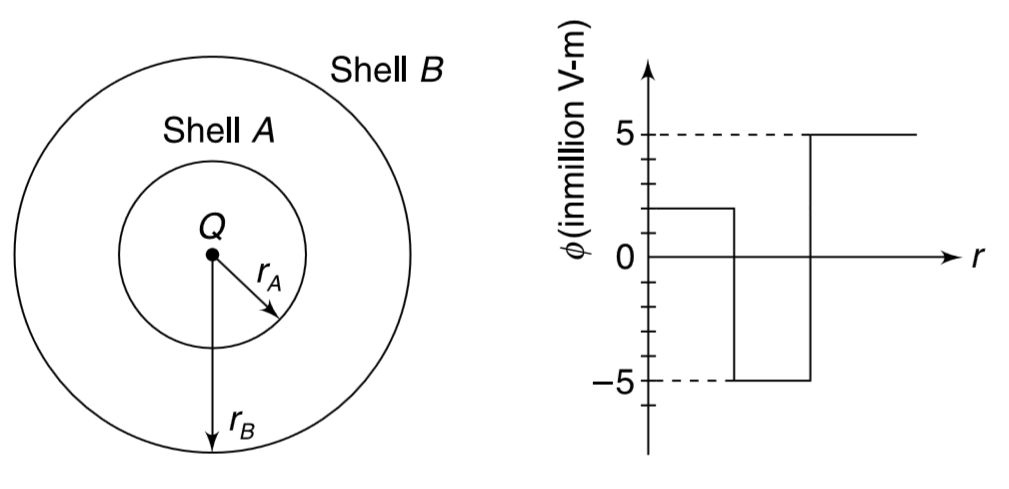figure shows, in cross section, two Gaussian spheres and two Gaussian cubes that are centered on a positively charged particle on a positively charged particle . Rank greatest first, and indicate whether the magnitudes are uniform or variable along each surface.

net flux through all the four Gaussion surface will be equal
the magnitude of the electric . Fields on the surface (i) and (ii) will be constant
the magnitude of the electric fields on the surfaces (ii) and (iv) will be variable
The magnitude of the electric fields on all the surfaces will be constant
The correct Answer is:a,b,c
Step by step video, text & image solution for figure shows, in cross section, two Gaussian spheres and two Gaussian cubes that are centered on a positively charged particle on a positively charged particle . Rank greatest first, and indicate whether the magnitudes are uniform or variable along each surface. by Physics experts to help you in doubts & scoring excellent marks in Class 12 exams.
Updated on:21/07/2023Topper's Solved these Questions
- ELECTRIC FLUX AND GAUSS LAWBOOK - CENGAGE PHYSICSCHAPTER - ELECTRIC FLUX AND GAUSS LAWEXERCISE - Subjective type
7 Videos
- ELECTRIC CURRENT AND CIRCUITBOOK - CENGAGE PHYSICSCHAPTER - ELECTRIC CURRENT AND CIRCUITEXERCISE - Interger
8 Videos
- ELECTRIC POTENTIALBOOK - CENGAGE PHYSICSCHAPTER - ELECTRIC POTENTIALEXERCISE - DPP 3.5
14 Videos
Similar Questions
In figure a close surface encloses two of the four positively charged particles. Which of the particles contribute to the elctric field at point P on the surface:
View SolutionTwo equal positive charges, each of 2μC interact with a third positive charge of 3μC situated as shown in Fig. Calculate the magnitude and direction of the force on the 3μC charge.

View Solution
Knowledge Check
figure shows, in cross section, two Gaussian spheres and two Gaussian cubes that are centered on a positively charged particle on a positively charged particle . Rank greatest first, and indicate whether the magnitudes are uniform or variable along each surface.
 Anet flux through all the four Gaussion surface will be equalBthe magnitude of the electric . Fields on the surface (i) and (ii) will be constantCthe magnitude of the electric fields on the surfaces (ii) and (iv) will be variableDThe magnitude of the electric fields on all the surfaces will be constant
Anet flux through all the four Gaussion surface will be equalBthe magnitude of the electric . Fields on the surface (i) and (ii) will be constantCthe magnitude of the electric fields on the surfaces (ii) and (iv) will be variableDThe magnitude of the electric fields on all the surfaces will be constantA positively charge particle moving along x-axis with a certain velocity enters a uniform electric field directed along positively y-axis. Its
AVertical velocity changes but horizontal velocity remains constantBHorizontal velocity changes but vertical velocity remiand constantCBoth vertical and horizontal velocities changeDNeither vertical nor horizontal velocity changes.A charged particle having a positive charge q approaches a grounded metallic spheres of raidus R with a constant small speed v as shown in figure. In this situation
 Aas the charge draws nearer to the surface of the sphere , a current flows into the ground.Bas the charge draws nearer to the surface of the sphere, a current flows out of the ground into the sphere.Cas the charged particle draws nearer, the magnitude of the current flowing in the connector joining the shell to the ground increasesDas the charged particle draws nearer, the magnitude of the current flowing in the connector joining the sphere to the ground decreases.
Aas the charge draws nearer to the surface of the sphere , a current flows into the ground.Bas the charge draws nearer to the surface of the sphere, a current flows out of the ground into the sphere.Cas the charged particle draws nearer, the magnitude of the current flowing in the connector joining the shell to the ground increasesDas the charged particle draws nearer, the magnitude of the current flowing in the connector joining the sphere to the ground decreases.
Two charged particles are placed at a distance 1.0 cm apart. What is the minimum possible magnitude of the electric force acting o each charge?
View Solution
A charged particle is placed at the centre of two thin concentric spherical charged shells, made of non-conducting material. Figure A shows cross-section of the arrangement. Figure B gives the net flux ϕ through a Gaussian sphere centered on the particle, as a function of the radius r of the sphere. (a) Find charge on the central particle and shell A. (b) In which range of the finite values of r, is the electric field zero?
View SolutionThe figure here shows three equal currents i (two parallel and one antiparallel) and four Amperian loops. Rank the loops according to the magnitude of ∮ along each, greatest first.

View SolutionIn a region, steady and uniform electric and magnetic fields are present . These two fields are parallel to each other. A charged particle is released from rest in this region . The path of the particle will be a
View SolutionThe figure shows four arrangement of three particles of equal masses. Rank the arrangement according to the magnitude of the net gravitational force on the particle m, greatest first.

View Solution
